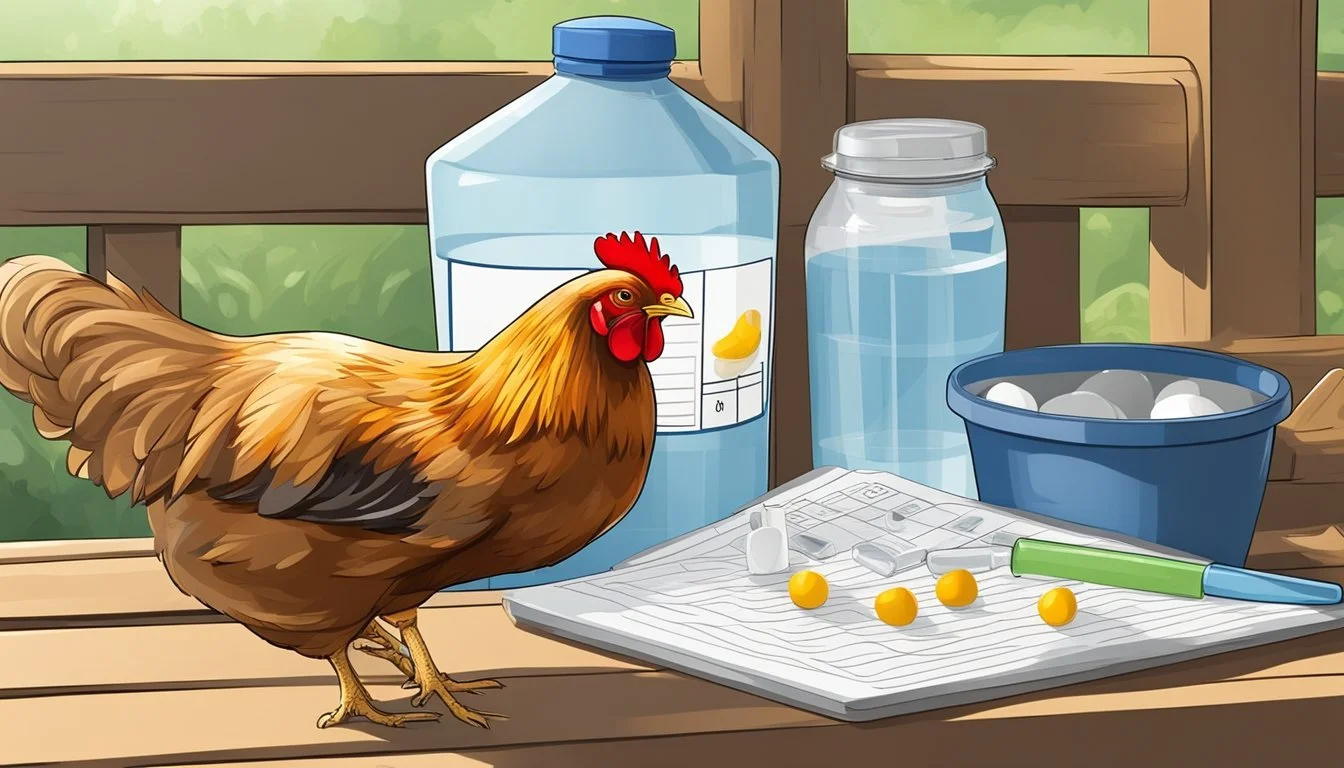How Do I Determine the Correct Dosage of Medication for My Chickens
Expert Dosage Guidelines
Determining the correct dosage of medication for chickens is a critical aspect of poultry care. It ensures that the birds receive the appropriate treatment for their condition while minimizing the risk of drug resistance or potential harm. Poultry keepers must consider factors such as the bird's weight, the type of medication, the method of delivery, and the specific instructions provided by the veterinarian or the medication label.
Accurate dosing is not only essential for the health and wellbeing of chickens but is also a requirement to adhere to food safety regulations. Overmedication can lead to harmful residues in meat and eggs, whereas underdosing might not effectively treat the ailment, leaving the chickens vulnerable to disease. It also plays a significant role in maintaining optimal production, as a healthy flock has better growth, laying capacity, and feed conversion.
When calculating the dosage, poultry owners can find guidance through antimicrobial prescribing guidelines for poultry or product-specific information such as that provided for Safe-Guard® AquaSol for Poultry. It's always best practice to consult a veterinarian for the exact dosage and treatment regime suitable for the specific needs of a flock.
Understanding Poultry Health and Medication Needs
Proper medication dosing for poultry hinges on recognizing the specific health challenges they face and ensuring correct administration as prescribed by an avian health professional.
Recognizing Clinical Signs in Chickens
Chickens may exhibit clinical signs indicating the presence of an infection or disease. These symptoms can range from respiratory distress, changes in droppings, lethargy, reduced egg production, to physical signs such as lesions or necrotic enteritis. It's crucial for poultry owners, whether they maintain a backyard flock or care for game birds like pheasants or quail, to identify these signs promptly to minimize stress and potential death amongst the birds.
Importance of a Veterinarian Consultation
Consultation with an avian vet is imperative for the accurate diagnosis of poultry diseases. A veterinarian can conduct a thorough examination and may recommend laboratory diagnostic tests to determine the root cause of the health issue. For any pet bird, a flock of turkeys, or even wild birds that have interacted with a backyard flock, a vet's diagnosis can guide effective treatment protocols and medication dosages.
Differences in Medication for Different Poultry
Not all poultry species respond to medications in the same way. Chickens, turkeys, ducks, geese, and other poultry such as pheasants and quail may require different dosages or medications. Factors influencing these differences include the bird's size, metabolic rate, and the specific pathogen causing the disease. Animal health professionals can provide dosing regimens tailored to the needs of each species within the flock.
Administering Medication Effectively
Effective medication administration to chickens involves accurate dosage determination, employing suitable application methods, and diligent monitoring to assess treatment efficacy.
Determining Correct Dosage
Dosage is paramount in treating chickens to ensure therapeutic effectiveness without causing harm. It involves calculating the amount of medication, often based on the weight of the bird, and adjusting for factors such as age, potential resistance, and the intended prevention or treatment of specific symptoms. For precision in dosage calculations, individuals may employ methods such as the Ratio and Proportion Method for Dosage Calculation, which takes into account the chicken's body weight and the medication's potency.
Medication Application Methods
Two primary administration routes for chicken medication are through feed or drinking water. When medication is administered via feed, it ensures that the drug is incorporated into food, whereas water administration can be preferable for ease of dosage adjustments and promoting compliance. It's critical to follow the medication's guidelines to determine the most effective delivery method that supports recovery without inducing unnecessary weight loss or food avoidance.
Feed: Mix the medication thoroughly with the feed.
Water: Dissolve the correct dosage in the flock's drinking supply.
Monitoring for Medication Efficacy
After administration, observing the chicken's response to medication is crucial. This involves tracking any changes in symptoms, behavior, and general health status to evaluate recovery progress. Signs of effective treatment include a return to normal activity levels and weight stabilization. Monitoring also helps identify and manage any potential drug resistance, informing whether the treatment strategy needs to be adjusted. Regular observation ensures that the goal of both treatment and prevention is being met, safeguarding the flock's health.
Common Chicken Diseases and Treatments
In caring for chickens, it is crucial to understand the common diseases they face and effective treatments. Proper medication dosing, based on disease diagnosis, can prevent escalation and reduce mortality.
Preventing and Treating Parasites
External parasites like mites, lice, and various types of worms can severely impact poultry health. Worming is a routine practice to combat internal parasites. For external parasites, various treatments, such as dusting powders and sprays specifically designed for poultry, can be effectively used to alleviate infestations.
Addressing Coccidiosis in Chickens
Coccidiosis in chickens is caused by protozoa of the genus Eimeria. This disease manifests as lesions in the intestinal mucosa and can be identified by the presence of oocysts in the feces. Treatment typically includes anticoccidial medication and maintaining clean litter. Vaccination may also be used to stimulate resistance to this illness.
Combatting Necrotic Enteritis
Necrotic Enteritis, brought on by Clostridium bacteria, results in necrotic lesions in the intestines. Symptoms include reduced growth and, potentially, death. The utilization of proper antibiotics under veterinary guidance can treat the condition, and maintaining good coop hygiene can help prevent its occurrence.
Medication Safety and Resistance Management
Ensuring the health of your chickens involves accurate medication dosing and rigorous management of potential resistance. One must follow safety protocols and comply with regulations when administering medications to prevent the development of antimicrobial resistance that could compromise the effectiveness of antibiotics.
Safely Administering Antibiotics and Other Medications
When administering antibiotics like tylosin or tetracyclines, or non-antibiotic additives such as ionophores, it is critical to adhere to the dosage instructions provided by the manufacturer or as prescribed by a veterinarian. This compliance ensures safety and therapeutic efficacy. It is beneficial to incorporate a systematic approach:
Double-check calculations: Always verify medication measurements for the right concentration.
Follow proper administration techniques: Administer through the appropriate route, whether in the water, by injection, or mixed in feed.
Maintain biosecurity measures: Prevent contamination through strict hygiene practices.
Record-keeping: Keep thorough records of medications administered, dosages, and the dates of treatment.
These steps aid in maintaining the health of the flock and minimize the risk of medication errors that could lead to overdose, underdose, or inappropriate treatment.
Understanding and Preventing Antimicrobial Resistance
Antimicrobial resistance is a significant concern in poultry farming. It is imperative to understand how misusing or overusing antibiotics can lead to resistant strains of pathogens. Here are some ways to manage resistance:
Judicious use of antibiotics: Only use antibiotics when necessary and under veterinary guidance.
Rotate antibiotics: Avoid using the same class of antibiotic continuously to reduce the chance of resistance development.
Alternative strategies: Consider using probiotics, prebiotics, or other feed additives to promote health, which may reduce the need for antibiotics.
By implementing these measures, farmers can contribute to the global effort to combat antimicrobial resistance and ensure the continued availability of effective treatment options for their flocks.
Optimizing Poultry Farming Practices
Effective poultry farming practices hinge on precision in administering medication, stringent biosecurity, and comprehensive flock management. Each aspect of care is critical for maintaining poultry health and preventing disease outbreaks.
Enhancing Biosecurity Measures
Biosecurity is the foundation of disease prevention in poultry farming. It includes practices that minimize the risk of pathogenic agents entering or spreading within a flock. Key measures involve controlling visitor access and implementing stringent sanitation protocols for personnel and equipment. Secure storage of feed and water is essential to prevent contamination from rodents and wild birds.
Managing Dietary Needs and Feed Quality
High-quality feed and water are the cornerstones of chicken health and effective medication. To ensure optimal nutrient intake and medication efficacy, farmers must provide a consistent supply of clean water and feed that meets the specific nutritional needs of the flock. Regular quality checks of feed can prevent issues related to deficient or excess nutrients that could exacerbate stress and disease vulnerability.
Stress Reduction and Flock Management
Stress can lead to increased susceptibility to disease, affecting medication absorption and efficacy. Practices such as avoiding overcrowding, maintaining proper ventilation to reduce dust and ammonia levels, and managing litter quality help to minimize stress. Monitoring of flock behaviour and mortality rates is essential to rapidly identify and address potential stressors.
Effective Use of Wormers and Parasite Control
Parasitic infections can compromise a chicken's health and interfere with medication absorption. Administering the correct dosage of wormers like fenbendazole, ivermectin, levamisole, and flubendazole is critical. Each bird should receive an accurate dose directly rather than in feed or water to ensure the treatment is effective.
Vaccine Protocols for Disease Prevention
Vaccination is a proactive strategy to protect chickens from disease. Effective prevention requires a planned schedule that considers the specific risks to the flock. Vaccines should be stored and administered according to manufacturer recommendations, and vaccine programs should be regularly reviewed for both backyard chickens and breeder flocks to maintain defense against pathogenic colonization.
Legal and Ethical Considerations
When determining the correct dosage of medication for chickens, it is vital to consider both legal and ethical implications. Adherence to medication regulations ensures compliance with the law, while understanding label instructions and off-label use respects ethical treatment within the poultry industry.
Compliance with Medication Regulations
Legal compliance is paramount. The poultry industry is governed by strict regulations to ensure the safety of both the animals and the consumers of poultry products. One must adhere to the Food and Drug Administration (FDA) guidelines, which oversee the approval and usage of veterinary drugs. The FDA sets forth clear legal foundations and national guidelines for safe medication administration that poultry farmers must follow.
Understanding Label Instructions and Off-label Use
Legally, one must understand and follow the label instructions provided by medication manufacturers. These instructions are crafted to ensure ethical treatment of poultry and the safety of medications. However, off-label use of medication—in which a drug is used in a manner not specified in the FDA's approved packaging label—may sometimes be necessary. Such practices should only be executed under the guidance of a licensed veterinarian, who bears the responsibility for making informed decisions respecting the animals' well-being and public health considerations.
It's important to note that off-label use is a common and necessary practice in veterinary medicine, including the poultry industry, as there are fewer approved drugs for animals than for humans. Nevertheless, one must ensure that off-label use falls within the bounds of legal standards and ethical considerations, maintaining a responsible approach to animal care.
Case Studies and Practical Experiences
In the poultry industry, determining the correct dosage of medication for chickens involves careful evaluation and a practical approach. Various case studies have shown the importance of dosing accuracy to prevent disease and reduce mortality rates in flock management. Treatment protocols drawn from these case studies can be instrumental for breeder flocks and commercial poultry operations.
For instance, one case study highlighted the application of a weight-based dosing regimen to control a respiratory disease outbreak in a broiler flock. The study underscored the necessity of adjusting doses based on the weight and age of the chickens to ensure efficacy and minimize resistance.
Treatment Plan:
Assessment: Veterinary evaluation of symptoms and flock health status.
Dosage Calculation: Based on chickens' weight, age, and severity of symptoms.
Administration: Through feed, water, or direct oral application.
Monitoring: Regular check-ups to assess treatment response and adjust dosages if necessary.
Another case documented in the provided resources, found on BCCNM, details a scenario where a new nurse in a rural practice needed to adjust medication dosages for different species, highlighting the distinct considerations to be taken for poultry compared to other animals.
In conclusion, a synthesis of these practical experiences suggests that a thorough understanding of avian physiology, disease specifics, and individual flock dynamics is critical to determining the correct medication dosages for chickens. The amalgamation of empirical data from case studies with field knowledge leads to improved outcomes in poultry health management.







